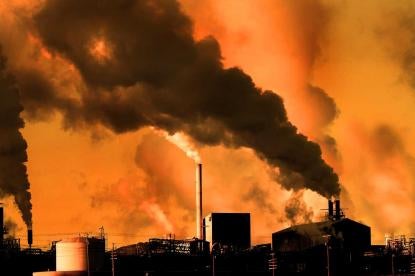On March 6, EPA published in the Federal Register a stringent new annual National Ambient Air Quality Standard (NAAQS) for fine particulate matter (PM2.5) pollution. Signed by Administrator Regan on February 7, the standard aims to protect public health by decreasing allowable emission levels of fine PM sized at 2.5 micrograms and smaller (PM2.5) while leaving standards for larger particulate matter sized at 10 micrograms and smaller (PM10) unchanged.
PM is the term for a mixture of solid particles and liquid droplets found in the air. PM2.5 consists of inhalable particles with diameters generally 2.5 micrometers (roughly 30 times smaller than the diameter of the average human hair).
Specifically, EPA is strengthening the primary (health-based) annual PM2.5 standard to 9.0 micrograms per cubic meter (μg/m3), down from the current limit of 12 μg/m3 that was set in 2012. EPA is not changing the current primary and secondary (welfare-based) 24-hour PM2.5 standards, secondary annual PM2.5 standard, or primary and secondary PM10 standards. EPA is also revising the Air Quality Index to improve public awareness of risks from PM2.5 exposures and changing the monitoring network to enhance protection of air quality in overburdened communities.
Publication in the Federal Register sets the effective date of the standards as May 6, 2024. Given recent delays between the promulgation of new regulations and their eventual publication in the Federal Register, the publication of the new PM standards less than a month after their official release shows progress in shrinking the delays other rules have experienced in getting officially published.
Implementation and Impacts
EPA set its planned timetable for states and the federal agency to implement the tightened annual PM2.5 NAAQS in an implementation memorandum released February 7. (That timetable is based on the schedule that the Clean Air Act set for and states to develop and implement the new NAAQS and therefore is subject to change due to a variety of circumstances.) The initial designations of areas of the country as meeting or violating the limit are targeted for 2026 with compliance deadlines beginning in 2032. States will have until February 7, 2025, to designate attainment areas as meeting the new annual standard and nonattainment areas as those areas not meeting the standard. EPA will then have an additional year to approve or modify those proposed state designations. For purposes of the implementation timetable, EPA notably deems the NAAQS to be promulgated as of February 7, 2024, even though the PM NAAQS rule will not become effective until May 6, 2024.
EPA projected that 2032 is the earliest possible year that states would need to demonstrate attainment of the standards as the planning process occurs over multiple years, and that other federal actions will drive further progress. EPA bases its modeling on concurrent agency actions and rulemakings that would impact air quality, including the forthcoming CO2 power plant rule and investments made from the Bipartisan Infrastructure Law (BIL) and Inflation Reduction Act (IRA). However, nonattainment issues will persist beyond 2032 in certain areas with more severe PM2.5 nonattainment problems, especially those areas in western states such as California.
All nonattainment areas will be initially listed as “moderate,” giving them six years from the issuance of nonattainment designations in 2026 to attain the standards, placing the target compliance date on February 7, 2032. The timing for implementing emissions controls could begin roughly contemporaneous with the 2032 timeframe. Emissions controls would be necessary both to remedy local PM2.5 NAAQS exceedances within a particular state as well as to mitigate interstate transport impacts in downwind PM2.5 nonattainment areas in other states. Emission controls will likely include reducing both direct PM as well as precursor air pollutants, such as nitrogen oxides (NOx) and sulfur dioxide (SO2).
In issuing the final PM2.5 rule, EPA asserts that the new PM2.5 NAAQS will not pose a significant compliance burden for states and industry. EPA projects the rule will prevent 4,500 premature deaths and 290,000 lost workdays and yield up to $46 billion in net health benefits in 2032. However, given the stringent level, the new standard will likely have a significant impact on new projects meeting permitting requirements and the need for areas in nonattainment of the standard to craft measures to attain the limit given how close 9 μg/m3 is to background levels of PM2.5.
Responding to concerns that increasingly frequent and severe wildfires will undermine implementation of the NAAQS, EPA is offering new regulatory tools to assist air agencies evaluate and exclude PM2.5 NAAQS exceedances resulting from wildfires, controlled burnings, and other such “exceptional events.”
With the rollout of the new annual PM2.5 standard, EPA provided maps of the areas already meeting the finalized PM2.5 limit, as well as its projections of the areas expected still to be in nonattainment beginning in 2032. While the maps are based on existing air monitoring data and preliminary modeling assumptions, EPA acknowledged that PM2.5 nonattainment forecasts are being provided for illustrative purposes only and not definitively predictive of future air quality outcomes. EPA projects that by 2032, 99 percent of U.S. counties will be in compliance with the new NAAQS, based on current emissions trends and state and federal regulations in effect as of 2032. Further analysis and evaluation will be necessary to assess EPA’s projections regarding the geographic scope for the classification of both current and future nonattainment areas.


Next Steps
The final PM2.5 NAAQS takes legal effect on May 6, 2024. States will have until February 7, 2025 to designate areas as meeting the new annual PM2.5 standard or not meeting the standard, and EPA will have until February 7, 2026, to approve or modify those designations. Deadlines for implementing emission controls for direct particulate matter and precursor emissions (such as NOx and SO2) will begin in 2032. Challenges to the new standard are due by May 6, 2024. A coalition of two dozen states already filed suit against EPA to vacate the agency’s final action on March 6 in the D.C. Circuit.







 i
i


